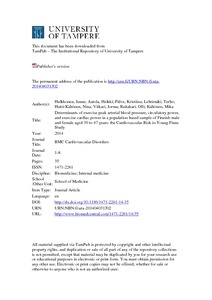Determinants of exercise peak arterial blood pressure, circulatory power, and exercise cardiac power in a population based sample of Finnish male and female aged 30 to 47 years: the Cardiovascular Risk in Young Finns Study
Hulkkonen, Janne; Aatola, Heikki; Pälve, Kristiina; Lehtimäki, Terho; Hutri-Kähönen, Nina; Viikari, Jorma; Raitakari, Olli; Kähönen, Mika (2014)
Hulkkonen, Janne
Aatola, Heikki
Pälve, Kristiina
Lehtimäki, Terho
Hutri-Kähönen, Nina
Viikari, Jorma
Raitakari, Olli
Kähönen, Mika
2014
BMC Cardiovascular Disorders 14
35
Lääketieteen yksikkö - School of Medicine
This publication is copyrighted. You may download, display and print it for Your own personal use. Commercial use is prohibited.
Julkaisun pysyvä osoite on
https://urn.fi/URN:NBN:fi:uta-201404031302
https://urn.fi/URN:NBN:fi:uta-201404031302
Kuvaus
BioMed Central open access
Tiivistelmä
Background
Novel parameters derived from peak maximal oxygen uptake (VO2) and exercise arterial blood pressure, such as peak circulatory power (CP) and exercise cardiac power (ECP), can be used in the risk assessment of cardiovascular disease and stroke. However, the determinants of these factors are poorly characterized in the general population.
Methods
We assessed peak arterial blood pressure, CP and ECP with standardized cardiopulmonary exercise test (CPET) on 281 female and 257 male participants of the Cardiovascular Risk in Young Finns Study. The subjects were aged 30–47 years. Peak VO2 as well as systolic and diastolic arterial blood pressures were measured to calculate peak mean arterial pressure, CP and ECP. These parameters were assessed for correlation with sex, age, height, weight, waist-to-hip ratio, smoking, physical activity index (PAI), fasting insulin and glucose levels as well as the use of antihypertensive treatment.
Results
Sex, age and weight explained 36% of the variation in peak systolic blood pressure, and these factors in combination with height and the use of antihypertensive treatment explained 13% of the variation in peak diastolic blood pressure. Sex, height, weight, waist-to-hip ratio, PAI and smoking explained 49% − 52% of the variation in peak CP. Sex, age, height, weight, waist-to-hip ratio, PAI, smoking and insulin levels explained 21% − 49% of variation in ECP.
Conclusions
Subject demographics and lifestyle-related factors should be taken into account when exercise blood pressure response, CP and ECP are used to evaluate patients’ cardiac function in CPET.
Novel parameters derived from peak maximal oxygen uptake (VO2) and exercise arterial blood pressure, such as peak circulatory power (CP) and exercise cardiac power (ECP), can be used in the risk assessment of cardiovascular disease and stroke. However, the determinants of these factors are poorly characterized in the general population.
Methods
We assessed peak arterial blood pressure, CP and ECP with standardized cardiopulmonary exercise test (CPET) on 281 female and 257 male participants of the Cardiovascular Risk in Young Finns Study. The subjects were aged 30–47 years. Peak VO2 as well as systolic and diastolic arterial blood pressures were measured to calculate peak mean arterial pressure, CP and ECP. These parameters were assessed for correlation with sex, age, height, weight, waist-to-hip ratio, smoking, physical activity index (PAI), fasting insulin and glucose levels as well as the use of antihypertensive treatment.
Results
Sex, age and weight explained 36% of the variation in peak systolic blood pressure, and these factors in combination with height and the use of antihypertensive treatment explained 13% of the variation in peak diastolic blood pressure. Sex, height, weight, waist-to-hip ratio, PAI and smoking explained 49% − 52% of the variation in peak CP. Sex, age, height, weight, waist-to-hip ratio, PAI, smoking and insulin levels explained 21% − 49% of variation in ECP.
Conclusions
Subject demographics and lifestyle-related factors should be taken into account when exercise blood pressure response, CP and ECP are used to evaluate patients’ cardiac function in CPET.
Kokoelmat
- Artikkelit [6140]
